Showing food fact sheet for wheat
Wholesome Wheat
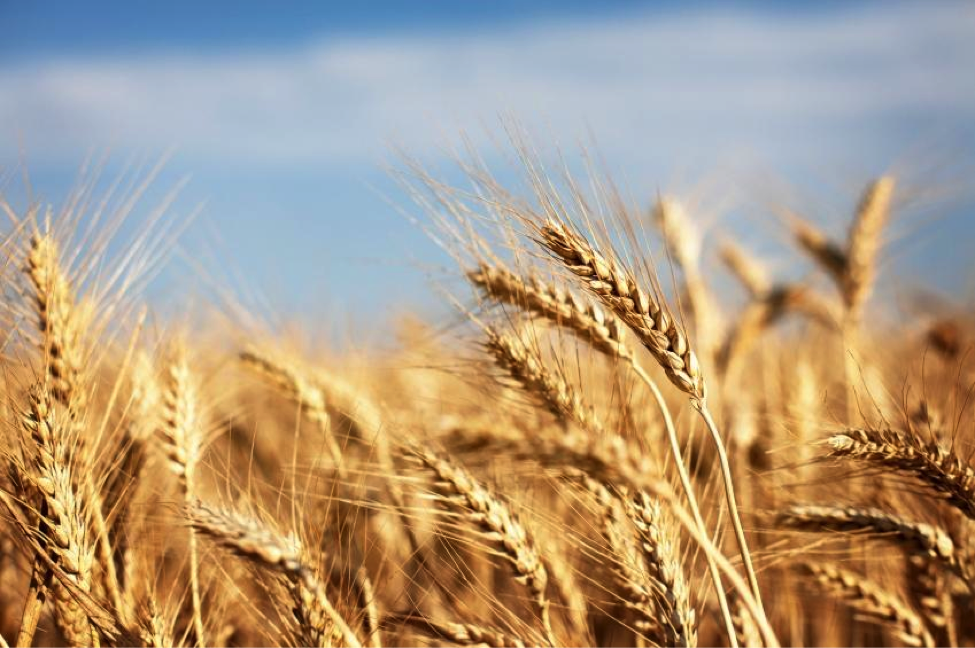 |
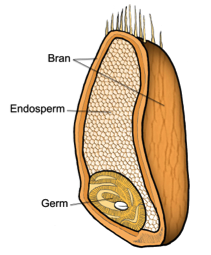 |
| Figure 2. Detail of wheat grain |
| image: http://www.thecookingmentor.com/cooking-basics/ cereals-grains/ |
Alberta wouldn't be the same without its rolling fields of golden wheat, and neither would our diets! From breads and cakes to pasta and cereal, wheat in its many forms is a true staple. As Canadians, we sit near the top of global production, ranking 6th in the world [FAO]. But the history of wheat as a major food crop dates back to 10,000 years ago, where it was discovered as a food in what is now south-eastern Turkey, gradually spreading to the rest of the world [Shewry, Heun]. Scientifically known as Triticum, wheat was first processed into flour by using a mortar and pestle, but now goes through a more modern milling process [Dexter]. The most valuable part of the wheat grain is the starchy endosperm, which makes up the majority of the kernel and is processed into flour [Catterall]. Because we're always trying to figure out how to best access the endosperm, sometimes we forget the importance of both the wheat germ (the embryo, what nourishes the growing wheat plant) and the wheat bran (outer layer of the wheat kernel). In fact, contained within these two parts of the wheat grain are most of wheat's beneficial nutrients, which is why "whole grain" really does matter! Wheat has many health properties that you might not know about, such as preventing heart disease, diabetes, cancer, improving immune function, and even helping with weight management. Loaded with protein, vitamins and many minerals, it's easy to understand why wheat is so wonderful!
Vitamins in Wheat
 |
| Figure 3. Structural diagram of pantothenic acid |
Wheat is rich in B-complex vitamins (B1, B3, B5, B6 and folate), that are found in all parts of the grain [USDA]. These vitamins are used throughout the body, primarily in energy metabolism. The most common form of vitamin B1 (or thiamin) in the body is as the cofactor cocarboxylase (or TPP) [McDowell]. TPP plays a role in the citric acid cycle (as a cofactor to pyruvate dehydrogenase), used to generate energy from carbohydrates. Thiamin and its derivatives (TPP, Thiamin triphosphate or TTP and thiamin monophosphate or TMP) are important in nerve function. The mechanism is unclear, but likely to do with nerve transmission. When nerves are stimulated, levels of TPP and TTP decrease, free thiamin and TMP are released into fluid surrounding the nerve. The Several neurological disease are related to thiamin deficiency, including beriberi and Wernicke's syndrome (associated with alcoholism) [McDowell]. vitamin B3 (or niacin) is used in many coenzymes integral to energy metabolism (NAD and its derivatives), and is beneficial for cardiovascular health, lowering LDL cholesterol and raising HDL cholesterol [Higdon]. Another vitamin in wheat is vitamin B5 (or pantothenic acid). Vitamin B5 is required for the ubiquitous coenzyme A synthesis - a coenzyme used in fatty acid metabolism (both oxidation and synthesis) and energy generation (in the citric acid cycle) [Daly]. vitamin B6 is a group of several similar compounds (including pyridoxine, pyridoxal, and pyridoxamine), used in over 100 enzymes [Erdman]! They can be found maintaining DNA and in the metabolism of carbohydrates, fats and proteins . And finally, there is folate (or vitamin B9). Folate is a supplement that all pregnant women require to prevent their babies from developing spinal cord problems (such as spina bifida or acephaly) and cognitive birth defects [Daly]. Folate is essential for the growth of new cells (especially red blood cells), and is also good for the heart, by breaking down homocysteine, an amino acid that increases risk of the disease [Wang]. Finally, folate can reduce side effects of certain arthritis medications and chemotherapies by replenishing diminished folate stores [Shea, Nadhananan].
Bottom line: The B-complex vitamins found in wheat are essential to digestion and energy metabolism.
Minerals in Wheat
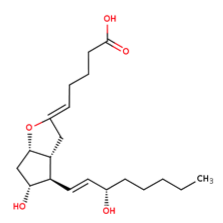 |
| Figure 4. Picture of prostacyclin |
Wheat naturally contains a host of amazing minerals - such as manganese, phosphorus, magnesium, zinc, and iron [USDA]! In recent years, farmers have fortified their wheat to have even higher mineral amounts, so eating a slice of bread can be just as good as taking your supplements! Manganese is a component of many enzymes that are used in metabolic pathways. These enzymes are found in protein, carbohydrate and cholesterol metabolisms. A manganese deficiency has been implicated in many bone-related problems, and some metabolic issues [National Research Council]. With the hefty dose of manganese in wheat comes anti-aging effects such as stronger cartilage and cell membranes, and prevention against cancer [Fardet]. Like calcium, phosphorus is very abundant in the human body and is needed to keep teeth and bones strong and healthy. It is important in memory, growth, tissue repair, pH balancing, can be used to treat kidney stones, and much more [Loghman-Adham, Fardet]. Phosphorus is used throughout the body, often in a phosphate - a naturally occurring compound. Phosphates are important in energy storage, nucleic acids and membranes. Phosphorus and calcium form hydroxyapatite, which is found in bones and teeth [Uenishi]. Yet another mineral responsible for bone health that is found in wheat is magnesium, which humans are commonly deficient in. Magnesium is important in vital body functions, such as regulating blood pressure, nervous and muscular equilibrium [Kass]. The body balances mineral concentrations to ensure proper functioning, and when the body attempts to balance between magnesium and calcium, prostacyclin is released, causing vasodilation (blood vessel muscle relaxation - lowering blood pressure) [Rude]. Like magnesium, zinc is also an essential mineral for the human body that's important for blood pressure, nerve function and mental health. Contained in almost every tissue in our bodies, zinc is important for brain development and function, and has cell-signalling roles within various tissues [Walsh]. Associated with over 300 enzymes in the human body, zinc is critical in many processes such as immune function, homeostasis of cell processes, and metabolism [Frederickson]. It is an ionic signalling molecule, which means that it can move among various membrane channels and bind with proteins that depend on zinc [Frederickson, Yu]. Some of these many proteins include the DNA-binding proteins TFIIA, GAL4, g32P, the protein kinase C that is important in signal transduction pathways, and neurotransmitter receptor proteins gamma-aminobutyric acid (GABA) and N-methyl-D-aspartate (NMDA), which are important for the passing along signals in the brain [Walsh]. Finally, it's a commonly known fact that iron is very important in normal body functions, especially because it is an important part of the hemoglobin protein, which carries oxygen in the blood. Without enough iron, your body's ability to transport oxygen is reduced, and you're susceptible to anemia. Symptoms of this disease typically include tiredness, dizziness, and weakness.
Bottom Line: Ditch your supplements and eat wheat! It's rich in all sorts of minerals, making sure your body stays balanced and healthy.
Wheat, Whole Grains and Weight Management
A whole grain, as defined by the FDA, is the "intact, ground, cracked or flaked fruit of the grain whose principal components, the starchy endosperm, germ and bran, are present in the same relative proportions as they exist in the intact grain" [FDA/Jonnalagadda]. In other words, whole grain is the commercial equivalent of the grain that is grown on a plant. Refined grains often leave out parts of the bran and germ, reducing the nutritional content of the grain [Jonnalagadda]. An increased consumption of whole grains has been shown to have many benefits, some that are not in refined grains [Okarter/Mckeown 2009].
Hooray for whole wheat! Body mass index and body fat were lowered following consumption of whole grains across several studies [Mckeown 2009/Harland//Newby/Koh-Banerjee]. This does not make whole grain foodstuffs weight loss wonder drugs; research around whole grains and weight loss has been conflicting [Koh-Banerjee/Kristensen]. The mechanisms surrounding fat reducing effects of whole grain consumption are still unknown [Jonnalagadda]. Researchers suggest that it may have to do with a feeling of fullness (satiety) after eating foods such as whole grain wheat [Holt]. In this sense, wheat is beneficial for people with high fat levels. Yet, wheat is controversial in some circles. Recently, people have blamed wheat for causing the uptick in obesity across developed nations. That just one food could cause an obesity epidemic is highly unlikely, as there are many lifestyle choices that impact health. Scientists have debunked this claim, due to several factors, including the rise of obesity in places where wheat-based foods are not readily consumed, and wheat being a staple food for thousands of years prior to the present obesity epidemic [Brouns]. Furthermore, research indicates whole grains have a protective role against obesity (and metabolic syndrome), likely as a result of the fermentation of insoluble fiber that creates butyric acid [Fardet/Björck/Harris].
Bottom Line: Eat whole grains! They will improve your nutrition and protect you from obesity!
Whole Wheat and Heart Health
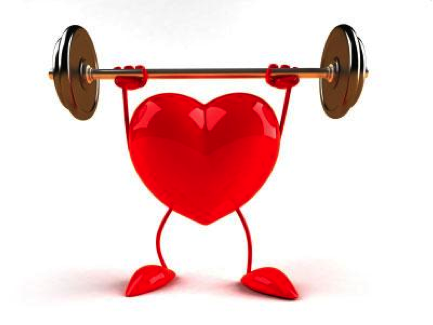 |
| Figure 5. A heart weightlifting |
images/Heart-Health.jpg) |
It's also possible that one specific part of the wheat bran, called the aleurone layer, can help prevent heart disease because it decreases "bad" cholesterol (LDL). Studies show that consumption of wheat with the aleurone layer will increase plasma betaine and will decrease the amount of homocysteine and LDL cholesterol, through the betaine-homocysteine methyltransferase pathway. This pathway requires betaine by consuming betaine or choline (which is transformed to betaine). High levels of homocysteine are known to increase the risk for cardiovascular disease and even Alzheimer's disease [Zeisel]. Various studies have found that betaine is key in lowering cholesterol [Price], and that wheat betaine is faster at reducing LDL cholesterol than any betaine supplements [Atkinson]! This decrease might also be quickened by other nutrients in the wheat: specifically folate and vitamin B12 [Atkinson].
Bottom line: Keep your heart ticking with whole grain wheat!
Anti-Cancer Phenols
Lignans are a type of polyphenolic compound found in plants, and wheat is no exception! Common lignans in wheat include secoisolariciresinol (SECO), lariciresinol (LARI), pinoresinol (PINO), matairesinol (MATA), and hydroxymatairesinol (HMR) [Cukelj]. Their anticancer effects stem from the fact that lignans are phytoestrogens, which means that they can mimic estrogen. But before they can do this, the plant lignans change into to mammalian lignans (enterodiol and enterolactone) through fermentation by bacteria in the colon [Begum,Heinonen]. Enterolactone is able to activate the estrogen receptors ER-alpha and ER-beta, inducing the estrogen responsive element (ERE), which contains reporter genes that fool the body into thinking that there is actually estrogen in the receptors [Penttinen]. This mimicry slows down the proliferation of the breast cancer cell MCF-7, which is sensitive to estrogen levels [Saarinen]. In many types of cancer (like prostate, breast, and colon), higher estrogen levels are thought to increase cancer cell growth, and so lignans may play a big role in preventing these diseases [Byland, Qu]. Interestingly enough, lignans can also help prevent cancer by inhibiting enzymes linked to proliferation of cancer cells, such as 3-beta-hydroxysteroid dehydrogenase, 5-alpha-reductase, phenol sulfatase, topoisomerase I and II, and aromatase [Adlercreutz]. One such enzyme, aromatase, is the synthesizer of estrogen[Chen]. Enterolactone can bind to aromatase active sites and inhibit the production of estrogen, reducing risk of breast and prostate cancer [Adlercreutz].
 |
| Figure 6. Structural diagram of ferulic acid |
Another important hydroxycinnamic, caffeic acid (not related to caffeine) has a number of beneficial anti-cancer properties. In one recent study, caffeic acid inhibited the B-cell lymphoma (Bcl-2) protein associated with apoptosis regulation, which led to a molecular domino effect that eventually killed the cancerous cells [Chang]. In another, caffeic acid was shown to have the same apoptosis-inducing effect on colon cancer cells [Jaganathan]. Plus, caffeic acid can unleash a barrage of cellularly-produced cancer-killing compounds, like reactive oxygen species (ROS) that damage a cancer cell's DNA and induce apoptosis [Rajendra]. Caffeic acid also has some very clear anti-inflammatory effects[de Cunha]. Caffeic acid will hunt down harmful chemicals in an effort to reduce inflammation, inhibit inflammatory genes, as well as reducing damage created by inflammation [de Cunha/Zhang/Yang].
Bottom line: Way to go wheat! When you eat the whole grain, anti-cancer benefits come straight from the bran!
Immunity-Boosting
Who knew that wheat could be so good for keeping your body disease-free? Two components of the fiber found in wheat bran have been shown to have anti-inflammatory properties. The polysaccharide beta-glucan has been shown to be beneficial because it initiates immune responses such as phagocytosis (when one cell "eats" another cell). Beta-glucan binds to the receptors of lymphocytes, specifically, membrane receptor dectin-1 [Brown]. These receptors are responsible for stimulating T-cell proliferation. This stimulation kickstarts the antimicrobial effects of beta-glucan, such as the phagocytosis of pathogens [Dritz]. But there are other parts of wheat that make it helpful for your immune system as well!
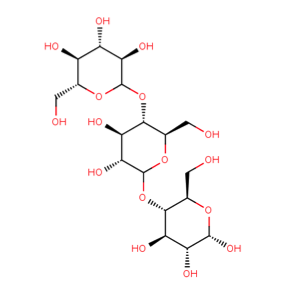 |
| Figure 7. Structural diagram of dextrin |
Bottom line: Our daily bread can help in the fight against disease and inflammation!
References
Introduction
- Shewry PR. Wheat. J Exp Bot. 2009;60(6):1537-1553.
- Heun M, Schäfer-Pregl R, Klawan D, Castagna R, Accerbi M, Borghi B, et al. Site of einkorn wheat domestication identified by DNA fingerprinting. Science. 1997;278(5341):1312–1314.
- Dexter JE, Wood PJ. Recent applications of debranning of wheat before milling. Trends Food Sci Tech. 1996;7(2):35-41.
- Catterall P, Cauvain SP. Technology of breadmaking. Springer US; 2007.Chapter 12, Flour milling; p.333-369.
Vitamins in Wheat
- United States Department of Agriculture. USDA National Nutrient Database for Standard Reference. http://ndb.nal.usda.gov/ndb/foods/show/6415 (accessed 12 August 2014).
- McDowell LR. Vitamins in Animal and Human Nutrition, 2 ed. Ames, ID: Iowa State University Press; 2000.
- Jane Higdon. Niacin. http://lpi.oregonstate.edu/infocenter/vitamins/niacin/ (accessed 12 August 2014).
- Daly LE, Kirke PN, Molloy A, Weir DG, Scott JM. Folate levels and neural tube defects. Implications for prevention. JAMA. 1995;274(21):1698-702.
- Erdman JE, MacDonald IA Jr, Zeisel SH. Present Knowledge in Nutrition. 10th ed. John Wiley & Sons; 2012.
- Wang L, Li H, Zhou Y, Jin L, Liu J. Low-dose B vitamins supplementation ameliorates cardiovascular risk: a double-blind randomized controlled trial in healthy Chinese elderly. Eur J Nutr. 2014;1-10.
- Shea B, Swinden MV, Ghogomu ET, Ortiz Z. Katchamart, W., Rader, T., et al. Folic Acid and Folinic Acid for Reducing Side Effects in Patients Receiving Methotrexate for Rheumatoid Arthritis. The J Rheumatol. 2014;41(6):1049-1060.
- Raghu Nadhanan R, Fan CM, Su YW, Howe PR, Xian CJ. Fish oil in comparison to folinic acid for protection against adverse effects of methotrexate chemotherapy on bone. J Orthop Res. 2014;32(4):587-596.
Minerals in Wheat
- USDA - cited in vitamins section
- National Research Council. Dietary Reference Intakes for Vitamin A, Vitamin K, Arsenic, Boron, Chromium, Copper, Iodine, Iron, Manganese, Molybdenum, Nickel, Silicon, Vanadium, and Zinc. Washington, DC: The National Academies Press, 2001.
- Fardet A. New hypotheses for the health-protective mechanisms of whole-grain cereals: what is beyond fibre? Nutr Res Rev. 2010;23(1):65-134.
- Loghman-Adham M. Adaptation to changes in dietary phosphorus intake in health and in renal failure. J Lab Clin Med.1997;129(2):176-188.
- Uenishi K. Phosphorus intake and bone health. Clin Calcium. 2009;19(12):1822-8.
- Kass L, Weekes J, Carpenter L. Effect of magnesium supplementation on blood pressure: a meta-analysis. Eur J Clin Nutr. 2012;66(4):411-418.
- Rude R, Manoogian C, Ehrlich L, DeRusso P, Ryzen E, Nadler J. Mechanisms of blood pressure regulation by magnesium in man. Magnesium. 1988;8(5-6):266-273.
- Walsh CT, Sandstead HH, Prasad ADS, Newberne PM, Fraker PJ. Zinc: health effects and research priorities for the 1990s.Enviro Health Psp. 1994;102(2):5-46.
- Frederickson CJ, Koh JY, Bush AI. The neurobiology of zinc in health and disease. Nat Rev Neurosci. 2005;6(6):449-462.
- Yu M, Lee WW, Tomar D, Pryschchep S, Czesnikiewicz-Guzik M, Lamar DL, Goronzy JJ. Regulation of T cell receptor signaling by activation-induced zinc influx. J Exp Med. 2011;208(4):775-785.
Wheat, Whole Grains and Weight Management
- United States Food and Drug Administration. FDA Provides Guidance on 'Whole Grain' for Manufacturers. http://www.fda.gov/NewsEvents/Newsroom/PressAnnouncements/2006/ucm108598.htm (accessed 22 July 2014).
- Jonnalagadda SS, Harnack L, Liu RH, McKeown N, Seal C, Liu S, et al. Putting the whole grain puzzle together: health benefits associated with whole grains--summary of American Society for Nutrition 2010 Satellite Symposium. J Nutr. 2011;141(5):1011S-22S.
- Okarter N, Liu RH. Health benefits of whole grain phytochemicals. Crit Rev Food Sci Nutr. 2010;50(3):193-208.
- McKeown NM, Yoshida M, Shea MK, Jacques PF, Lichtenstein AH, Rogers G, et al. Whole-grain intake and cereal fiber are associated with lower abdominal adiposity in older adults. J Nutr. 2009;139(10):1950-5.
- Harland JI, Garton LE. Whole-grain intake as a marker of healthy body weight and adiposity. Public Health Nutr. 2008;11(6):554-63.
- Newby PK, Maras J, Bakun P, Muller D, Ferrucci L, Tucker KL. Intake of whole grains, refined grains, and cereal fiber measured with 7-d diet records and associations with risk factors for chronic disease. Am J Clin Nutr. 2007;86(6):1745-53.
- Koh-Banerjee P, Franz M, Sampson L, Liu S, Jacobs DR Jr, Spiegelman D, et al. Changes in whole-grain, bran, and cereal fiber consumption in relation to 8-y weight gain among men. Am J Clin Nutr. 2004;80(5):1237-45.
- McKeown NM, Troy LM, Jacques PF, Hoffmann U, O'Donnell CJ, Fox CS. Whole- and refined-grain intakes are differentially associated with abdominal visceral and subcutaneous adiposity in healthy adults: the Framingham Heart Study. Am J Clin Nutr. 2010;92(5):1165-71.
- Kristensen M, Toubro S, Jensen MG, Ross AB, Riboldi G, Petronio M, et al. Whole grain compared with refined wheat decreases the percentage of body fat following a 12-week, energy-restricted dietary intervention in postmenopausal women. J Nutr. 2012;142(4):710-6.
- Holt SH, Brand-Miller JC, Stitt PA. The effects of equal-energy portions of different breads on blood glucose levels, feelings of fullness and subsequent food intake. J Am Diet Assoc. 2001;101(7):767-73.
- Brouns FJPH, van Buul VJ, Shewry PR. Does wheat make us fat and sick? Journal of Cereal Science. 2013;58(2):209-15
- Fardet, cited in Vitamins section.
- Björck I, Östman E, Kristensen M, Anson NM, Price RK, Haenen GRMM, et al. Cereal grains for nutrition and health benefits: Overview of results from in vitro, animal and human studies in the HEALTHGRAIN project. Trens in Food Science & Technology. 2012;25(2):87-100
- Harris KA, Kris-Etherton PM. Effects of whole grains on coronary heart disease risk. Curr Atheroscler Rep. 2010;12(6):368-76.
Wheat and Cardiovascular Disease
- Alwan A ed. Global status report on noncommunicable diseases. World Health Organization. 2010.
- Jonnalagadda SS, cited in Wheat, Whole Grains and Weight section.
- Flight I, Clifton P. Cereal grains and legumes in the prevention of coronary heart disease and stroke: a review of the literature. Eur J Clin Nutr. 2006 Oct;60(10):1145-59.
- Mellen PB, Walsh TF, Herrington DM. Whole grain intake and cardiovascular disease: a meta-analysis. Nutr Metab Cardiovasc Dis. 2008;18(4):283-90.
- Jacobs DR Jr, Meyer KA, Kushi LH, Folsom AR. Whole-grain intake may reduce the risk of ischemic heart disease death in postmenopausal women: the Iowa Women's Health Study.Am J Clin Nutr. 1998;68(2):248-57.
- Anderson JW. Whole grains protect against atherosclerotic cardiovascular disease. Proc Nutr Soc. 2003;62(1):135-42.
- Erkkilä AT, Herrington DM, Mozaffarian D, Lichtenstein AH. Cereal fiber and whole-grain intake are associated with reduced progression of coronary-artery atherosclerosis in postmenopausal women with coronary artery disease. Am Heart J. 2005;150(1):94-101.
- Flint AJ, Hu FB, Glynn RJ, Jensen MK, Franz M, Sampson L, et al. Whole grains and incident hypertension in men. Am J Clin Nutr. 2009 Sep;90(3):493-8.
- Harris, cited in the Wheat, Whole Grains and Weight Management section
- Zeisel SH, Da Costa KA. Choline: an essential nutrient for public health. Nutr Rev. 2009;67(11):615-623.
- Price RK, Keaveney EM, Hamill LL, Wallace JM, Ward M, Ueland PM, et al. Consumption of wheat aleurone-rich foods increases fasting plasma betaine and modestly decreases fasting homocysteine and LDL-cholesterol in adults. J Nutr. 2010;140(12):2153-2157.
- Atkinson W, Slow S, Elmslie J, Lever M, Chambers ST, George PM. Dietary and supplementary betaine: effects on betaine and homocysteine concentrations in males. Nutr Metab Cardiovasc Dis. 2009;19(11):767-773.
- Atkinson W, Elmslie J, Lever M, Chambers ST, George PM. Dietary and supplementary betaine: acute effects on plasma betaine and homocysteine concentrations under standard and postmethionine load conditions in healthy male subjects. Am J Clin Nutr. 2008;87(3):577–85.
Anti-cancer
- Čukelj N, Jakasa I, Sarajlija H, Novotni D, Ćurić D. Identification and quantification of lignans in wheat bran by gas chromatography-electron capture detection. Talanta. 2011;84(1):127-132.
- Begum AN, Nicolle C, Mila I, Lapierre C, Nagano K, Fukushima K, et al. Dietary lignins are precursors of mammalian lignans in rats. J Nutr. 2004;134(1):120-127.
- Heinonen S, Nurmi T, Liukkonen K, Poutanen K, Wähälä K, et al. In vitro metabolism of plant lignans: new precursors of mammalian lignans enterolactone and enterodiol. J Agr Food Chem. 2001;49(7):3178-3186.
- Penttinen P, Jaehrling J, Damdimopolous AE, Inzunza J, Lemmen JG, van der Saag P, et al. Diet-derived polyphenol metabolite enterolactone is a tissue-specific estrogen receptor activator. Endocrinology. 2007;148(10):4875-4886.
- Saarinen NM, Wärri A, Airio M, Smeds A, Mäkelä S. Role of dietary lignans in the reduction of breast cancer risk. Mol Nutr Food Res. 2007;51(7):857-866.
- Bylund A, Saarinen N, Zhang JX, Bergh A, Widmark A, Johansson A, et al. Anticancer effects of a plant lignan 7-hydroxymatairesinol on a prostate cancer model in vivo. Exp Biol Med. 2005;230(3):217-223.
- Qu H, Madl RL, Takemoto DJ, Baybutt RC, Wang W. Lignans are involved in the antitumor activity of wheat bran in colon cancer SW480 cells. J Nutr. 2005;135(3):598-602.
- Adlercreutz A. Phyto-oestrogens and cancer. Lancet Oncol. 2002;3(6):364-373.
- Chen S. Aromatase and breast cancer. Front Biosci. 1998;3:d922-d933.
- Adlercreutz H, Bannwart C, Wähälä K, Mäkelä T, Brunow G, Hase T, et al. Inhibition of human aromatase by mammalian lignans and isoflavonoid phytoestrogens. J Steroid Biochem. 1993;44(2):147-153.
- Slavin JL, Martini MC, Jacobs DR, Marquart L. Plausible mechanisms for the protectiveness of whole grains. Am J Clin Nutr. 1999;70(3):459s-463s.
- Liu RH. Whole grain phytochemicals and health. J Cereal Sci. 2007;46(3):207-219.
- Li, L., Shewry PR, Ward JL. Phenolic acids in wheat varieties in the HEALTHGRAIN diversity screen. J Agr Food Chem. 2008;56(21):9732-9739.
- Alias LM, Manoharan S, Vellaichamy L, Balakrishnan S, Ramachandran CR. Protective effect of ferulic acid on 7,12-dimethylbenz[a]anthracene-induced skin carcinogenesis in Swiss albino mice. Exp Toxicol Pathol. 2009;61(3):205-14.
- Karthikeyan S, Kanimozhi G, Prasad NR, Mahalakshmi R. Radiosensitizing effect of ferulic acid on human cervical carcinoma cells in vitro. Toxicol In Vitro. 2011;25(7):1366-75.
- Peng CC, Chyau CC, Wang HE, Chang CH, Chen KC, Chou KY, et al. Cytotoxicity of ferulic Acid on T24 cell line differentiated by different microenvironments. Biomed Res Int. 2013;2103:579859
- Prabhakar MM, Vasudevan K, Karthikeyan S, Baskaran N, Silvan S, Manoharan S. Anti-cell proliferative efficacy of ferulic acid against 7, 12-dimethylbenz(a) anthracene induced hamster buccal pouch carcinogenesis. Asian Pac J Cancer Prev. 2012;13(10):5207-11.
- Chang WC, Hsieh CH, Hsiao MW, Lin WC, Hung YC, Ye JC. Caffeic acid induces apoptosis in human cervical cancer cells through the mitochondrial pathway. Taiwan J Obstet Gynecol. 2010;49(4):419-24.
- Jaganathan SK. Growth inhibition by caffeic acid, one of the phenolic constituents of honey, in HCT 15 colon cancer cells. Scientific World Journal. 2012;2012:372345.
- Rajendra Prasad N, Karthikeyan A, Karthikeyan S, Reddy BV. Inhibitory effect of caffeic acid on cancer cell proliferation by oxidative mechanism in human HT-1080 fibrosarcoma cell line. Mol Cell Biochem. 2011;349(1-2):11-9.
- da Cunha FM, Duma D, Assreuy J, Buzzi FC, Niero R, Campos MM, et al. Caffeic acid derivatives: in vitro and in vivo anti-inflammatory properties. Free Radic Res. 2004:38(11):1241-53.
- Zhang M, Zhou J, Wang L, Li B, Guo J, Guan X. Caffeic acid reduces cutaneous tumor necrosis factor alpha (TNF-α), IL-6 and IL-1β levels and ameliorates skin edema in acute and chronic model of cutaneous inflammation in mice. Biol Pharm Bull. 2014;37(3):347-54.
- Yang WS, Jeong D, Yi YS, Park JG, Seo H, Moh SH. IRAK1/4-targeted anti-inflammatory action of caffeic acid. Mediators Inflamm. 2013;2013:518183.
Immunity boosting
- Brown GD, Gordon S. Immune recognition: a new receptor for β-glucans. Nature. 2001;413(6851):36-37.
- Dritz SS, Shi J, Kielian TL, Goodband RD, Nelssen JL, Tokach MD. Influence of dietary beta-glucan on growth performance, nonspecific immunity, and resistance to Streptococcus suis infection in weanling pigs. J Anim Sci.1995;73(11):3341-3350.
- Gibson GR, Roberfroid MB. Dietary modulation of the human colonic microbiota: introducing the concept of prebiotics. J Nutr. 1995;125(6):1401-12.
- Roberfroid M. Prebiotics: the concept revisited. J Nutr. 2007;137(3 Suppl 2):830S-7S.
- Moshfegh AJ, Friday JE, Goldman JP, Ahuja JK. Presence of inulin and oligofructose in the diets of Americans. J Nutr. 1999;129(7 Suppl):1407S-11S.
- Slavin J. Fiber and Prebiotics: Mechanisms and Health Benefits. Nutrients. 2013;5(4):1417-1435.
- van Loo J, Coussement P, de Leenheer L, Hoebregs H, Smits G. On the presence of inulin and oligofructose as natural ingredients in the western diet. Crit Rev Food Sci Nutr. 1995;35(6):525-52.
- Costabile A, Klinder A, Fava F, Napolitano A, Fogliano V, Leonard C, et al. Whole-grain wheat breakfast cereal has a prebiotic effect on the human gut microbiota: a double-blind, placebo-controlled, crossover study. Br J Nutr. 2008 Jan;99(1):110-20.
- Schley PD, Field CJ. The immune-enhancing effects of dietary fibres and prebiotics. Brit J Nutr. 2002;87(S2):S221-S230.
- Calder PC, Yaqoob P. Glutamine and the immune system. Amino Acids. 1999;17(3):227-241.
- Cohn M. What roles do regulatory T cells play in the control of the adaptive immune response?. Int Immunol. 2008;20(9):1107-1118.
- Klampfer L, Huang J, Sasazuki T, Shirasawa S, Augenlicht L. Inhibition of Interferon γ Signaling by the Short Chain Fatty Acid Butyrate. Mol Cancer Res. 2003;1(11):855-62.
- Inan MS, Rasoulpour RJ, Yin L, Hubbard AK, Rosenberg DW, Giardina C. The luminal short-chain fatty acid butyrate modulates NF-κB activity in a human colonic epithelial cell line. Gastroenterology. 2000;118(4):724-734.
- Vieira AT, Teixeira MM, Martins FS. The role of probiotics and prebiotics in inducing gut immunity. Front Immunol. 2013;4(445):1-12.
Diabetes
- Anderson JW, Baird P, Davis RH Jr, Ferreri S, Knudtson M, Koraym A, et al. Health benefits of dietary fiber. Nutr Rev. 2009;67(4):188-205.
- Post RE, Mainous AG 3rd, King DE, Simpson KN. Dietary fiber for the treatment of type 2 diabetes mellitus: a meta-analysis. J Am Board Fam Med. 2012;25(1):16-23.
- Silva FM, Kramer CK, de Almeida JC, Steemburgo T, Gross JL, Azevedo MJ. Fiber intake and glycemic control in patients with type 2 diabetes mellitus: a systematic review with meta-analysis of randomized controlled trials. Nutr Rev. 2013;71(12):790-801.
- Chandalia M, Garg A, Lutjohann D, von Bergmann K, Grundy SM, Brinkley LJ. Beneficial effects of high dietary fiber intake in patients with type 2 diabetes mellitus. N Engl J Med. 2000;342(19):1392-8.
- Kaline K, Bornstein SR, Bergmann A, Hauner H, Schwarz PE. The importance and effect of dietary fiber in diabetes prevention with particular consideration of whole grain products. Horm Metab Res. 2007;39(9):687-93.
- Salmerón J, Manson JE, Stampfer MJ, Colditz GA, Wing AL, Willett WC. Dietary fiber, glycemic load, and risk of non-insulin-dependent diabetes mellitus in women. JAMA. 1997;277(6):472-7.
- Babio N, Balanza R, Basulto J, Bulló M, Salas-Salvadó J. Dietary fibre: influence on body weight, glycemic control and plasma cholesterol profile. Nutr Hosp. 2010 May-Jun;25(3):327-40.